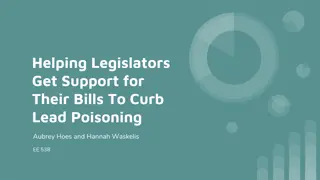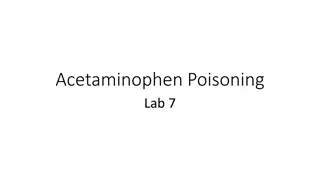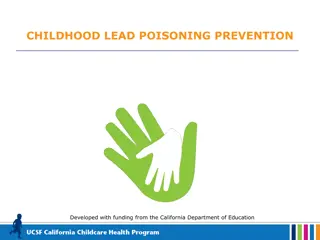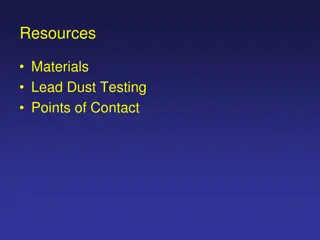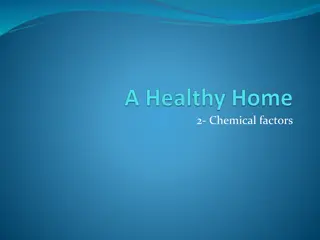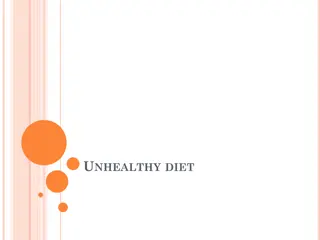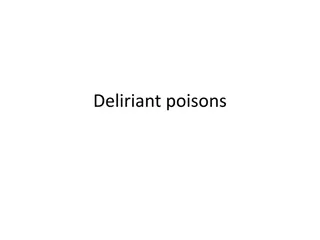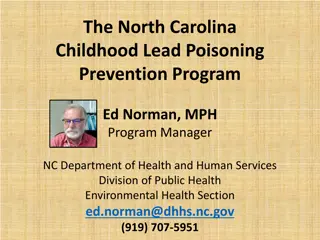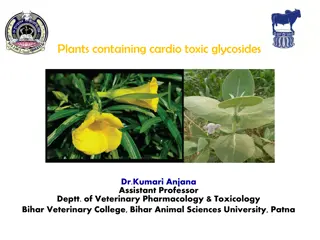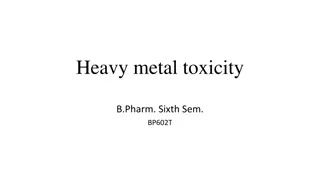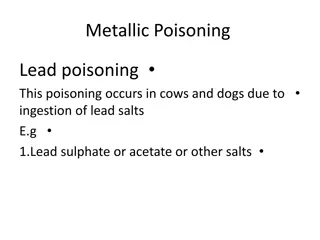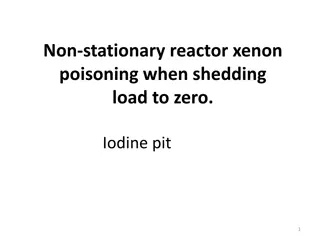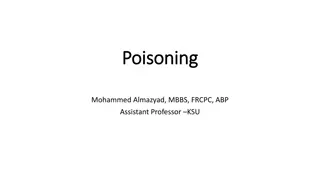
Toxicology Approaches and Care Guidelines
Discover the comprehensive approach and care guidelines in toxicology, including antidotes, support measures, and decontamination options. Learn about managing toxic exposures effectively to ensure patient safety and well-being.
Download Presentation

Please find below an Image/Link to download the presentation.
The content on the website is provided AS IS for your information and personal use only. It may not be sold, licensed, or shared on other websites without obtaining consent from the author. If you encounter any issues during the download, it is possible that the publisher has removed the file from their server.
You are allowed to download the files provided on this website for personal or commercial use, subject to the condition that they are used lawfully. All files are the property of their respective owners.
The content on the website is provided AS IS for your information and personal use only. It may not be sold, licensed, or shared on other websites without obtaining consent from the author.
E N D
Presentation Transcript
What is there that is not poison? All things are poison and nothing [is] without poison. Solely the dose determines that a thing is not a poison Philip Theophrastus Bombast von Hohenheim aka PARACELSUS (1493-1541)
Most toxic exposures will get better simply with meticulous supportive care Not everybody needs the full court press Issues to address frequent assessment decontamination enhancement of elimination Antidotes Toxidromes
General Approach ABC s of Toxicology A-Antidotes and alter absorption (in some instances prior to airway-decontamination with organophosphates to protect others, cyanide toxicity where antidotes are lifesaving) B-Basics; ABC s C-Change metabolism (NAC, ethanol) D-Distribute differently (calcium gluconate, O2) E-Elimination (diuresis, dialysis, hemoperfusion)
Airway, breathing, circulation Establish IV, O2 and cardiac monitor Consider coma cocktail Thiamine, D50, Naloxone Evaluate history and a thorough physical exam Look at vitals, pupils, neuro, skin, bowel sounds. . . Gives you hints regarding the general class of toxins Guides your supportive care Draw blood / urine for testing Time to consider decontamination options
Beware of the Stable patient Consider possible polysubstance exposures Be prepared for deterioration IV access Cardiac monitor Pulse oximetry
Many standard practices now virtually extinct Forced emesis, forced lavage, charcoal anytime Removal of contaminated clothing, substances on skin or in eyes Charcoal Gastric lavage Whole Bowel Irrigation
Used far less now than in past Having stomach pumped, with large tube inserted into stomach, suctioned, and lavaged Risk of perforation, aspiration, and simply not working Contraindicated in comatose or seizing patients, unprotected airways, extended release preparations
Can be a brutal procedure Indication: life threatening ingestions that occurred within one hour Airway protection is key Limited indications Lots of complications
Gastric lavage Peter JV, Moran JL, Pichamuthu K, Chacko B. Adjuncts and alternatives to oxime therapy in organophosphate poisoning is there evidence of benefit in human poisoning? A review. Anaesth Intensive Care 2008; 36: 339-50
Basically, everybody gets a dose Works to adsorb substances to its matrix Not for metals, caustics Generally safe, few contraindications Aspiration, bowel obstruction Dosing 1g/kg po dose, +/- single dose of cathartic
Caustics and corrosives Heavy metals Alcohols Rapid absorption (cyanide, strychnine) Chlorine and iodine Other agents insoluble in water Aliphatics (petroleum distillates) Laxatives (Mg, K, Na)
Loss of protective reflexes drugs likely to cause rapid depressed consciousness or early seizures infants < 6 months of age ingested foreign body neurologically impaired absent bowel sounds or obstruction unstable patients
Pretty Damn Short QTc Phenobarbital Dapsone Salicylates Quinine Theophylline Carbemazepine
Isotonic polyethylene glycol electrolyte solutions Large volumes ingested wash the substances through the bowel cleanses gut of intoxicants PEG solutions at 2 Liters/hour effective for use in LA preparations, body packers/stuffers, and some substances poorly absorbed by charcoal (ex iron) contraindicated if hematemesis, ileus, obstruction, perforation, or peritonitis Dose in volume sufficient to create clear rectal effluent
In other words, get rid of the toxin faster Cathartics - used, but no study showing benefit Alkalinization salicylates Hemodialysis Hemoperfusion
Very limited number of antidotes given the vast array of pharmaceuticals and chemicals Coma Cocktail glucose thiamine naloxone ** NOT flumazenil**
Toxin Paracetamol Tricyclics Opiates Organophosphates Heavy metals Iron Digoxin Beta-blocker Calcium channel blockers Cyanide Antidote N acetylcysteine Na bicarbonate Naloxaone 2 PAM BAL Desferoxamine Dig Fab (Digibind) Glucagon Calcium, glucagon, gluc/insulin Sodium nitrite, sodium thiosulfate, hydroxycobalamine
Toxin Methanol, ethylene glycol Methemoglobinemia Anticholinergics Isoniazid Snakebites Antidote Fomepizole (Antizole) Methylene blue Physostigmine Pyridoxine Antivenom
Needs circulatory or respiratory support altered mental status > 3 hours seizures arrhythmia second or third degree heart block widened QRS unresponsive to verbal stimuli arterial pCO2 > 45 mmHg
29 year old man found down Ex-room mates transport to ED Reports from scene: he took something No pill bottles on scene No family with him Roommates that found him are long gone He is now in your ED
Start with the basics Airway, breathing, circulation Get a better history Get relatives to get pill bottles, tell you what they do know (found outside, inside, garage ) Call friends, family, neighbors Call psych or primary physician to know regular drugs Get him to tell Always remember that suicidal patients (just like everyone else) can lie so be skeptical of their history
CNS level of arousal, GCS, pupils, behaviour, neurologic exam CVS rate, rhythm Resp pattern, depth, wheezing GI bowel sounds, distention Skin color, temp, signs of trauma Odors
Comatose: Tox screen, glu, NH4, CT scan, CSF analysis Respiratory toxin: ABG, CXR, spirometry, pulse ox Cardiac toxin: EKG, ECHO, cardiac enzymes, hemodynamic monitoring
Tox Screens Toxic screening is rarely necessary when patients are asymptomatic or have clinical findings consistent with the medical history. However, screening for acetaminophen and salicylates is strongly recommended for patients with an uncertain history or intentional poisoning
Establish a pattern to his symptoms Toxic syndrome Also known as a: TOXIDROME
It is the association of several clinically recognizable features, signs, symptoms, phenomena or characteristics which often occur together, so that the presence of one feature alerts the physician to the presence of the others.
Symptoms & Signs History Vital signs Simple labs
Not every drug fits into a broad based category Lots of meds have unique effects not easily grouped Physiologic fingerprints that occur in the form of syndromes or groups of symptoms which are observed to occur together in response to exposure to one of a pharmacologically similar group of agents Useful in determining the class of agents involved in an unknown poisoning
Sympathomimetics Anticholinergics Cholinergics Opiates Seditive Hypnotics Neuroleptic Malignant Syndrome Serotonergic syndrome (Hallucinogenic)
Cocaine Methamphetamine/Amphetam ines Ecstasy (MDMA) ADHD meds like ritalin, adderal Ephedrine Caffeine
Tachycardia +/- arrythmias Hypertension +/- ICH Hyperthermia, mydriasis, convulsions, diaphoresis, seizure, central nervous system (CNS) excitation psychosis, Rhabdomyolysis Mimics Anticholinergic except WET compared to DRY Diaphoresis and normal bowel sounds with sympathomimetic toxidrome Dry skin and absent bowel sounds with anticholinergic toxidrome
Supportive care Monitor airway, diagnose ICH, rhabdo IVF for insensible loses and volume repletion Benzos, benzos, benzos, benzos BP mgmt if severe NEVER GIVE BETA BLOCKERS Behavioral Agitation CNS excitation Cardiac excitation
heroin_pic syringeshare heroin_poppy heroin heroin%2520drug%2520f5 inject heroin
Opiate: derived directly from the opium poppy morphine and codeine Opioids: much broader class of agents capable of producing opium-like effects or of binding to opioid receptors Heroin Methadone meperidine Hydrocodone Oxycodone
Triad of: Coma Miosis (not always seen; demerol actually dilates) Respiratory depression Peripheral vasodilation, hypotension Flushing (histamine) Bronchospasm Pulmonary edema Seizures (meperidine, propoxyphene) Hypothermia Bradycardia
Competitive opioid antagonist: Naloxone Goal of return of spontanous respirations sufficient to ventilate the patient appropriately May have to re-dose as opiates may act longer than antagonist There are other longer acting opioid antagonists such as nalmefene and naltrexone but not often used
Benadryl-D_Allergy_and_Sinus_Tablets-resized200 200 Tylenol_PM_150CAP_enlarge 200
TCA Scopolamine/polo Neuroleptics Parkinson meds Benzotropine/trihexphendyl Jimson weed Antihistamines Methylqualone Piperdones, Gyromitra
Hot as Hades - Fever Fast as a Hare - Tachycardia Dry as a Bone Lack of diaphoresis Red as a Beet Flushed skin Mad as a Hatter Delerium Full as a Tick Urinary retention Blind as a Bat Mydriasis
Supportive care IVF to replace insensible losses from agitation, hyperthermia Benzos to stop agitation Physostigmine Induces cholinergic effects Short acting May help with uncontrollable delirium Do not use if ingestion not known Danger with TCAs & CHB
D - Diarrhea U - Urination M - Miosis BBB Bradycardia, Bronchorrhea, Bronchospasm E - Emesis L - Lacrimation S Salivation, Seizures
Antagonize muscarinic symptoms Atropine Stop aging of enzyme blockade 2-PAM Prevent and terminate seizures Diazepam Supportive care
makers_mark_gr ghb
Different agents have different mechanisms Many interfere in the GABA system
CNS depression, lethargy Can induce respiratory depression Can produce bradycardia or hypotension
Supportive care Be wary of the benzo antidote Flumazinil Is an antagonist at the benzo receptor RARELY INDICATED If seizures develop either because of benzo withdrawal, a co-ingestant or metabolic derangements, have to use 2nd line agents, barbiturates, for seizure control
Rare, life-threatening Reaction to neuroleptic medication All anti-psychotics may precipitate - typical or atypical - potent neuroleptics most frequent

